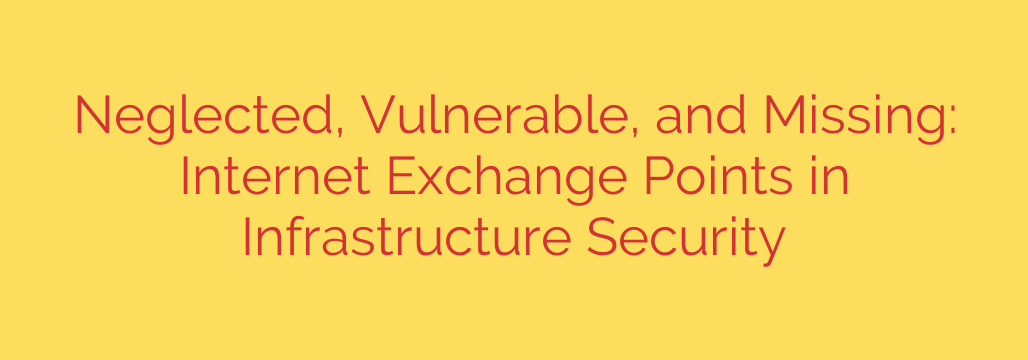
The Hidden Backbone of the Internet: Why Securing Internet Exchange Points is Critical
When you send an email or stream a video, the data seems to travel magically across the globe. But behind the scenes, a complex physical infrastructure makes it all possible. A crucial, yet often overlooked, component of this infrastructure is the Internet Exchange Point, or IXP.
These are the digital crossroads of the internet—physical locations where different network operators, like internet service providers (ISPs), content delivery networks (CDNs), and large tech companies, connect their networks directly. Think of an IXP as a major highway interchange, allowing traffic from different roads to switch routes efficiently without having to travel through a congested city center.
By enabling direct “peering,” IXPs make the internet faster, cheaper, and more resilient. They keep local traffic local, reducing latency and lowering costs for everyone. However, their critical importance also makes them a prime target, and a widespread lack of security focus has left these hubs dangerously vulnerable.
The Core Vulnerabilities: Why IXPs Are at Risk
The very nature of an IXP creates security challenges that demand urgent attention. While they provide immense benefits, they also concentrate risk, making them attractive targets for malicious actors.
1. A Single Point of Critical Failure
An IXP is a centralized point for a massive volume of internet traffic. A successful attack that takes an IXP offline, whether through a physical breach or a digital one like a Distributed Denial-of-Service (DDoS) attack, can have devastating consequences. It can disrupt internet connectivity for an entire city or region, severing access to essential services, financial systems, and communication platforms.
2. The Threat of BGP Hijacking
The internet relies on the Border Gateway Protocol (BGP) to route traffic between different networks (known as autonomous systems). At an IXP, malicious actors can exploit BGP’s trust-based design to perform a “route hijack.”
By falsely announcing that they own a specific block of IP addresses, attackers can reroute traffic intended for legitimate services—like banks or government websites—through their own servers. This allows them to intercept sensitive data, conduct espionage, or simply drop the traffic to create an outage. This is one of the most significant threats to internet stability today.
3. Inconsistent Security Standards
There is no global governing body that mandates security standards for all IXPs. While many are run by responsible operators, others may lack the resources or expertise to implement robust security measures. This creates a patchwork of security postures, where the overall strength of the internet is only as strong as its weakest link. Participation in security initiatives is often voluntary, meaning crucial best practices are not universally adopted.
The High Cost of Missing Infrastructure
Just as a vulnerable IXP poses a threat, the complete absence of one creates different but equally serious problems. In many developing regions, there are few or no local IXPs.
This forces local internet traffic to take incredibly inefficient, long-distance routes. For example, an email sent between two users in the same African city might have to travel to Europe and back. This “tromboning” effect results in:
- Increased Latency: Slower internet performance for users.
- Higher Costs: Network operators must pay for expensive international transit.
- Reduced Resilience: The longer data path introduces more potential points of failure.
- Data Sovereignty Concerns: Local data is routed through foreign jurisdictions, raising privacy and security questions.
Establishing more IXPs in underserved areas is a critical step toward building a more equitable and resilient global internet.
Actionable Steps for a More Secure Internet
Securing the internet’s core is a shared responsibility. Network operators, IXP managers, and policymakers must work together to harden this critical infrastructure.
Here are essential security measures that can be taken:
- Implement MANRS: Network operators should adopt the Mutually Agreed Norms for Routing Security (MANRS), a global initiative that provides crucial fixes for BGP vulnerabilities. This includes filtering to prevent the propagation of incorrect routing information.
- Deploy RPKI: Resource Public Key Infrastructure (RPKI) is a technology that allows network operators to cryptographically verify that an entity has the right to announce a specific route. Widespread RPKI adoption is one of the most effective defenses against BGP hijacking.
- Secure Route Servers: IXPs must harden their route servers—the machines that manage peering sessions—against attacks. This includes regular patching, access control, and continuous monitoring.
- Promote Security as a Prerequisite: IXPs should encourage or even mandate minimum security practices for all participating members, making a secure posture a condition of peering.
- Recognize IXPs as Critical Infrastructure: Governments and policymakers must officially classify IXPs as critical national infrastructure. This designation can unlock funding for security upgrades, promote better regulatory oversight, and ensure IXPs are included in national cybersecurity strategies.
By focusing on securing existing IXPs and promoting the development of new ones, we can protect the foundation of our digital world and ensure the internet remains a reliable and trustworthy resource for generations to come.
Source: https://go.theregister.com/feed/www.theregister.com/2025/07/31/ixp_resilience_call/








